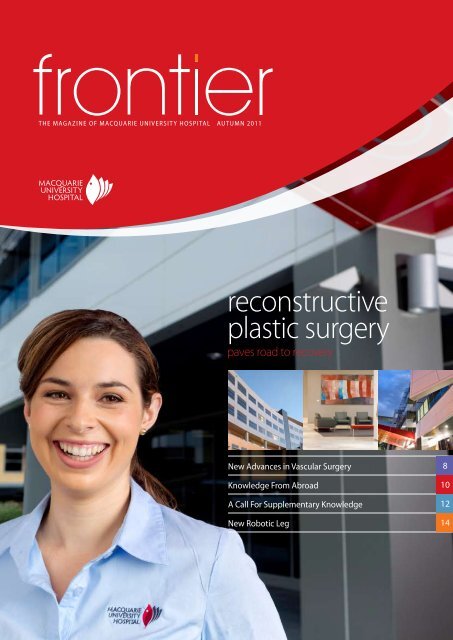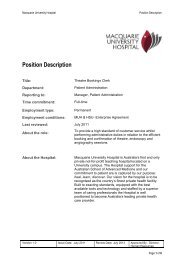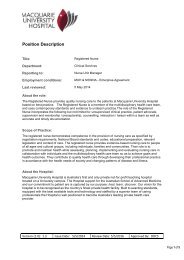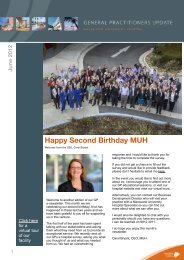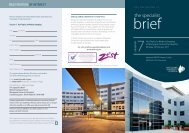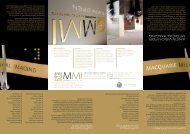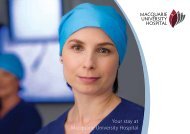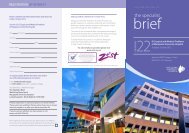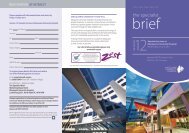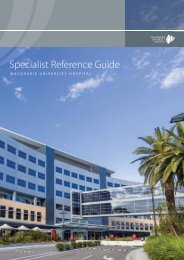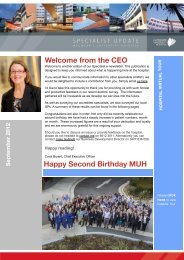reconstructive plastic surgery - Macquarie University Hospital
reconstructive plastic surgery - Macquarie University Hospital
reconstructive plastic surgery - Macquarie University Hospital
You also want an ePaper? Increase the reach of your titles
YUMPU automatically turns print PDFs into web optimized ePapers that Google loves.
the magazine of macquarie university hospital • autumn 2011<br />
<strong>reconstructive</strong><br />
<strong>plastic</strong> <strong>surgery</strong><br />
paves road to recovery<br />
New Advances in Vascular Surgery<br />
Knowledge From Abroad<br />
A Call For Supplementary Knowledge<br />
New Robotic Leg<br />
1<br />
8<br />
10<br />
12<br />
14
2<br />
4<br />
8<br />
10<br />
12<br />
<strong>reconstructive</strong> <strong>plastic</strong><br />
<strong>surgery</strong> paves roaD to<br />
recovery<br />
neW aDvances in<br />
vascular <strong>surgery</strong><br />
KnoWleDge from<br />
aBroaD: a neW approach<br />
to shoulDer <strong>surgery</strong><br />
a call for<br />
supplementary<br />
KnoWleDge<br />
14<br />
16<br />
19<br />
20<br />
22<br />
24<br />
26<br />
28<br />
30<br />
neW roBotic leg<br />
getting cancer voices hearD<br />
specialist Brief series<br />
What lies Beneath<br />
innovation<br />
first class catering<br />
goes DoWn Well<br />
neWs in Brief<br />
valuing our efforts<br />
helicopter transfers
Frontier / <strong>Macquarie</strong> <strong>University</strong><br />
<strong>Hospital</strong> 2011<br />
Please direct all editorial enquires<br />
to Katherine Filippi,<br />
Marketing Manager (Editor)<br />
02 9812 3099<br />
katherine.filippi@muh.org.au<br />
Writer: Andrea Lewis<br />
Contributor:<br />
Michelle Wilson-Webster<br />
<strong>Macquarie</strong> <strong>University</strong> <strong>Hospital</strong>,<br />
3 Technology Place,<br />
<strong>Macquarie</strong> <strong>University</strong> NSW 2109<br />
www.muh.org.au<br />
WelCoMe<br />
TO <strong>Macquarie</strong> universiTy hOspiTal<br />
We are fast approaching our first<br />
year anniversary. It has been an<br />
exciting year for everyone involved<br />
in the development of this hospital.<br />
Although we opened in June 2010,<br />
the bedding down of systems and<br />
services has continued throughout<br />
the year.<br />
To ensure the sustained success of<br />
this project our staff have worked<br />
at an extraordinary pace.<br />
In ordinary circumstances, the<br />
multifaceted nature of opening<br />
and staffing a brand new hospital<br />
is challenging. Generally, Australian<br />
private hospitals have emerged<br />
from smaller private health-related<br />
facilities or public institutions.<br />
Alternatively, private hospital<br />
groups have built new facilities by<br />
replicating and transferring<br />
knowledge and processes.<br />
We however have built our hospital<br />
and its systems from the ground<br />
up, by pooling the collective<br />
knowledge of some of the country’s<br />
most experienced administrative<br />
and medical health professionals.<br />
The further challenge we have<br />
faced is introducing a number of<br />
new technologies and processes,<br />
many of which have been untested<br />
in the Australian market.<br />
These included building and<br />
operating Australia’s first fully<br />
digital private hospital, with an<br />
electronic health record, and the<br />
installation of a number of<br />
state-of-the-art technologies<br />
including Australia’s first and<br />
only Gamma Knife, and the first<br />
world-class cyclotron, CT Theatre<br />
and a Hybrid Theatre in a private<br />
hospital.<br />
Although the journey has not<br />
been without trial, we can now<br />
unequivocally boast operating the<br />
most advanced private hospital in<br />
the country.<br />
All that has been accomplished<br />
to date has been achieved by<br />
challenging the current status quo<br />
within the industry. We have<br />
examined the private hospital<br />
sector, to see if there are areas<br />
within it, that can be improved<br />
upon with the aim of delivering<br />
superior support services to<br />
clinical staff, patients and visitors.<br />
In this inaugural year we have<br />
remained flexible, examining<br />
whether these new systems and<br />
processes are working optimally<br />
with the aim of identifying faulty<br />
approaches before they become<br />
entrenched in our culture. In order<br />
to remain the most innovative<br />
hospital we must continually<br />
challenge ourselves.<br />
I am extremely proud to lead this<br />
exceptional team. The employees<br />
of MUH have collectively set a new<br />
benchmark for the provision of<br />
health services within Australia.<br />
Robert Glynn,<br />
CEO, <strong>Macquarie</strong> <strong>University</strong><br />
<strong>Hospital</strong><br />
2issue<br />
3
4<br />
ReCoNSTRUCTIVe<br />
PlASTIC SURGeRY<br />
PAVES ROAD TO RECOVERY<br />
Professor AnAnd devA<br />
And ChArlie AbdAllAh
PlASTiC SuRGEOnS AT<br />
MACquARiE uniVERSiTY<br />
HOSPiTAl HAVE PlAYED A kEY<br />
ROlE in SAVinG AnD EnHAnCinG<br />
THE quAliTY Of lifE Of CHARliE<br />
AbDAllAH wHO SuffERED<br />
MASSiVE injuRiES AfTER A CAR<br />
ACCiDEnT in 2003.<br />
When Charlie Abdallah had a car accident<br />
almost nine years ago, he suffered multiple<br />
and extremely serious injuries. The injuries<br />
were primarily internal abdominal injuries –<br />
failed kidneys, bowel and bladder, as well as<br />
collapsed lungs. Compromised blood supply<br />
to the right leg eventually led to a<br />
hindquarter amputation.<br />
“Basically, everything stopped working,<br />
except my heart and my brain,” said Charlie.<br />
“I have no recollection of the accident. I only<br />
remember waking up in intensive care after<br />
about a month.”<br />
Charlie stayed in liverpool <strong>Hospital</strong> for a year<br />
and nine months, spending nine months in<br />
intensive care and a year on the wards.<br />
Since then, he has had twenty additional<br />
surgeries. Some have been elective, some<br />
emergency. Many of them have involved<br />
<strong>reconstructive</strong> <strong>plastic</strong> <strong>surgery</strong>, attempting to<br />
close large wounds or lessen the build-up of<br />
scar tissue.<br />
Associate Professor Anand Deva, Head of<br />
Plastic Surgery at <strong>Macquarie</strong> <strong>University</strong><br />
<strong>Hospital</strong>, has been actively involved in<br />
Charlie’s case since the night he was first<br />
admitted to hospital.<br />
Part of the team who worked hard to get<br />
him through those initial weeks, Professor<br />
Deva said that Charlie is one of the sickest<br />
patients he’s seen who has gone on to<br />
survive so remarkably.<br />
“Whilst I was consulted when he first came<br />
in, my first major involvement with Charlie’s<br />
recovery was in 2004, when we attempted<br />
to heal the abdominal and pelvic wounds<br />
that had not closed since the accident,” said<br />
Professor Deva. “Because urine and bowel<br />
contents were leaking through the wound,<br />
it became a matter of priority to look at<br />
ways of closing these wounds.<br />
“To accelerate healing, the team used a<br />
vacuum sponge dressing, a relatively<br />
new technology used to treat chronic,<br />
non-healing wounds. This provided a rapid<br />
closure and healthy bed on which to place<br />
skin grafts, which ultimately achieved<br />
complete healing and prevented further<br />
loss of blood and body fluids.”<br />
The <strong>plastic</strong> <strong>surgery</strong> team later operated to<br />
provide padding to Charlie’s pelvic area to<br />
allow him to mobilise on a wheelchair.<br />
Professor Deva also performed a cosmetic<br />
nose operation to correct the appearance<br />
and function of Charlie’s nose, which was<br />
fractured during the accident.<br />
Their biggest challenge came with the most<br />
recent operation, performed at <strong>Macquarie</strong><br />
<strong>University</strong> <strong>Hospital</strong> early in 2011. The<br />
operation involved two procedures<br />
simultaneously: an ileostomy reversal and<br />
an abdominal reconstruction to address<br />
abdominal hernias that had resulted from<br />
loss of the majority of Charlie’s abdominal<br />
muscle and skin.<br />
5
6<br />
“it’s imPressive how, in<br />
PlAnning the hosPitAl,<br />
they looked At A lot of<br />
hosPitAl systems –<br />
it systems, the size of<br />
rooms, for exAmPle<br />
– And did A lot of<br />
AnAlysis, then APPlied<br />
thAt informAtion to<br />
ACtuAlly building<br />
the hosPitAl,” noted<br />
Professor devA.
To recreate new skin for a reconstruction,<br />
a process called tissue expansion was<br />
used. Balloons were placed under the skin<br />
and from July to November last year, they<br />
were gradually expanded by inflation with<br />
saline injections. The expansion of tissue<br />
generates new healthy skin, which is used<br />
to make up for the deficit.<br />
During the operation, Professor Deva and<br />
Professor Tony eyers, colorectal surgeon at<br />
<strong>Macquarie</strong> <strong>University</strong> <strong>Hospital</strong>, worked<br />
together first to reverse the ileostomy,<br />
then to reconstruct the abdominal<br />
muscles using a new dissolving mesh<br />
and, finally, to use the expanded skin to<br />
close the abdomen.<br />
“I’m doing a lot better now,” said Charlie.<br />
“The <strong>surgery</strong> at <strong>Macquarie</strong> <strong>University</strong><br />
<strong>Hospital</strong> was the biggest I’ve had since<br />
the initial injuries.<br />
“I am very grateful to Professor Deva and<br />
also to Professor Tony eyers. Professor eyers<br />
is known to be one of the best colorectal<br />
surgeons, and I was lucky enough to have<br />
him assist with the operation.<br />
Charlie says that having the <strong>surgery</strong> at<br />
<strong>Macquarie</strong> <strong>University</strong> <strong>Hospital</strong> was an<br />
amazing experience.<br />
“It’s a place where you feel very<br />
comfortable. In other hospitals, you just<br />
want to go home. At <strong>Macquarie</strong>, I felt very<br />
relaxed in my surroundings. You have<br />
enough physical pain in hospital, so it<br />
helps if you have a positive attitude, and<br />
your physical environment can give you<br />
that emotional comfort.<br />
“The hospital feels so contemporary. It’s<br />
colourful. You want to spend time there.<br />
even having computers over the beds with<br />
internet connection. I’ve never been in a<br />
hospital with internet connection. These<br />
little things mean a lot. You’re still in touch.”<br />
Charlie, who receives a lot of visitors when<br />
he is in hospital, says that even they were<br />
struck by how pleasant it was to be there<br />
– especially the outdoor areas where<br />
visitors can go to take a break.<br />
ChArlie exerCising<br />
“the hosPitAl feels<br />
so ContemPorAry.<br />
it’s Colourful. you<br />
wAnt to sPend time<br />
there. even hAving<br />
ComPuters over the<br />
beds with internet<br />
ConneCtion. i’ve<br />
never been in A<br />
hosPitAl with<br />
internet ConneCtion.<br />
these little things<br />
meAn A lot. you’re<br />
still in touCh.”<br />
From a doctor’s point of view, the hospital<br />
also breaks new ground.<br />
“It’s impressive how, in planning the<br />
hospital, they looked at a lot of hospital<br />
systems – IT systems, the size of rooms,<br />
for example – and did a lot of analysis,<br />
then applied that information to actually<br />
building the hospital,” noted Professor Deva.<br />
“The concept is unique in Australia. In the<br />
US, the top medical institutions – the<br />
Mayo Clinic, for example – are private<br />
university hospitals. These institutions<br />
attract the best doctors and so it is with<br />
<strong>Macquarie</strong> <strong>University</strong> <strong>Hospital</strong>.<br />
“It’s certainly given surgeons access to<br />
everything that we love. I’ve done fairly<br />
major operations there already and it’s<br />
remarkable to work in such a new, clean<br />
and technologically advanced<br />
environment.<br />
“I can do all facets of my work there – and<br />
do them well. I can take on challenging<br />
clinical cases; I can pursue my research<br />
program; I have access to the newest<br />
technologies; I can teach skills and<br />
techniques to the next generation of<br />
<strong>plastic</strong> surgeons; and I have adequate<br />
funding to pursue all these goals.”<br />
Clearly, it’s people like Charlie who<br />
benefit from such innovation – given his<br />
recent positive experience at the hospital.<br />
“It’s been a long and hard process but it’s<br />
an experience I couldn’t say I wish I had<br />
not gone through,” reflected Charlie. It’s<br />
given me a whole new perspective on life<br />
and what I want to do. Something like<br />
this moulds your personality.<br />
“I don’t wish it on anyone. The anguish of<br />
my family, seeing my parents facing such<br />
pain, has been the hardest thing. But, for<br />
me, who’s to say, if I hadn’t had this<br />
accident, where I would have ended up.<br />
“I did go through a short period of<br />
depression, but you get over it. I’ve never<br />
really felt anger. You just accept it. You get<br />
much better at facing obstacles in your<br />
life after everything you’ve gone through.”<br />
Getting two university degrees – a<br />
Bachelor of Software engineering and a<br />
Bachelor of Mathematics – while<br />
recovering from his injuries is a sure sign<br />
that Charlie hasn’t given up and is able<br />
and wanting to face new challenges. He<br />
also trains daily and drives a car.<br />
“I’d like to be a doctor eventually,”<br />
said Charlie.<br />
Responds Professor Deva: “The medical<br />
profession needs people like Charlie, who<br />
have been on the other side of the<br />
hospital experience.”<br />
7
8<br />
NeW ADVANCeS IN<br />
VASCUlAR SURGeRY<br />
THE VASCulAR DEPARTMEnT AT<br />
MACquARiE uniVERSiTY HOSPiTAl<br />
OffERS PATiEnTS THE lATEST in<br />
MiniMAllY inVASiVE EnDOVASCulAR<br />
SuRGERY, COMbinED wiTH THE<br />
bEST ulTRASOunD DiAGnOSTiC<br />
TECHnOlOGY.<br />
<strong>Macquarie</strong> <strong>University</strong> <strong>Hospital</strong> has<br />
established an innovative vascular<br />
department that combines the latest<br />
procedures and technologies in diagnostics<br />
and treatment. With some of the most<br />
skilled medical professionals on board, the<br />
hospital can offer patients the highest level<br />
of treatments available in Australia.<br />
From commonly presenting conditions to<br />
highly complex cases, the vascular team can<br />
address a range of diseases quickly and<br />
effectively.<br />
At the heart of the vascular capabilities in<br />
the hospital’s brand new hybrid operating<br />
suite, is a multi-modality room incorporating<br />
angiography capabilities and CT into the<br />
operating theatre. The hybrid theatre<br />
contains a robotic angiography device. The<br />
intelligent C-arm of the robotic device<br />
allows precision in access to a specific area<br />
being treated.<br />
Professor Geoffrey White, from the vascular<br />
department, stated that this robotic-guidance<br />
vascular intervention system is an important<br />
advance, which offers unrivalled innovative<br />
technology to our patients who require<br />
minimally invasive procedures to reopen<br />
blood vessels throughout the body. It makes<br />
<strong>Macquarie</strong> <strong>University</strong> <strong>Hospital</strong> an ideal place<br />
for a world centre of excellence in vascular,<br />
endovascular and cardiovascular care.<br />
“our patients benefit from this technology<br />
since the procedures can be completed<br />
more quickly and safely, usually under<br />
simple local anaesthesia, with return to<br />
home the same or next day,” said Professor<br />
White. “In addition, the robotic system<br />
incorporates state-of-the-art features, which<br />
allow us to reduce our patients’ exposure to<br />
x-rays, while providing advanced<br />
3-dimensional images of organs and vessels<br />
for complex procedures, including hybrid<br />
interventions which can combine the best<br />
combination of <strong>surgery</strong> and other<br />
technology, known as hybrid procedures.”<br />
Dr Michael Stephen, another of the<br />
well-respected vascular surgeons at<br />
<strong>Macquarie</strong> <strong>University</strong> <strong>Hospital</strong>, agrees that<br />
the hybrid operating theatre allows<br />
surgeons to perform the most advanced<br />
procedures very effectively and efficiently.<br />
“Vascular surgical advances are clearly<br />
oriented towards minimally invasive,<br />
endovascular procedures using radiological<br />
control,” said Dr Stephen. “<strong>Macquarie</strong><br />
<strong>University</strong> <strong>Hospital</strong> has one of the most<br />
advanced hybrid suites in the world. This<br />
high-resolution and the robotic capability<br />
also allows for complex endoluminal<br />
<strong>surgery</strong> to be undertaken, as well as the<br />
conventional and hybrid cases, without<br />
having to move the patient to a different<br />
theatre. This markedly simplifies the more<br />
standard interventions.”<br />
Through minimally invasive catheter<br />
procedures and endovascular and surgical<br />
reconstruction, vascular surgeons at<br />
<strong>Macquarie</strong> <strong>University</strong> <strong>Hospital</strong> work mostly<br />
in the three main arterial treatment areas.<br />
These are ischemic lower limbs (hardening<br />
of the arteries, causing leg pain or disability),<br />
aneurysms (particularly affecting the<br />
abdominal and thoracic aorta), and visceral<br />
arterial disease (including abdominal and<br />
cerebrovascular disease).<br />
The vascular team is fortunately placed by<br />
having expert close links with the<br />
cardiological and neurological departments<br />
to help both pre and post-operative<br />
assessment and management of individual<br />
patients. In combination with an advanced<br />
Intensive Care Unit, this multi-disciplinary<br />
approach adds a higher dimension of<br />
patient certainty and safety.<br />
All vascular surgeons are actively engaged<br />
in research through the Australian School in<br />
Advanced Medicine, doing clinical trials in<br />
areas including revascularisation of the smaller<br />
blood vessels, drug-eluting balloons and<br />
stents to deliver medication to hyper<strong>plastic</strong><br />
artery walls, and aortic dissections.<br />
The other big advance that <strong>Macquarie</strong><br />
brings to the vascular arena in the private<br />
sector is a highly sophisticated diagnostic<br />
vascular ultrasound laboratory.<br />
Kathryn Busch, Practice Manager of the<br />
laboratory, says that when <strong>Macquarie</strong><br />
established the laboratory, decisions were<br />
taken to install only the newest and the most<br />
accurate diagnostic equipment available.<br />
“The ultrasound we have in the lab is the<br />
Philips iU22,” explained Ms Busch. “It’s the<br />
newest on the market and able to produce<br />
extraordinarily high-resolution results. Many<br />
of our patients can have their arterial or<br />
venous problem diagnosed by ultrasound,<br />
which allows many to avoid the need for<br />
vascular x-rays.”<br />
The technology uses an ultra-thin targeted<br />
ultrasound beam that, by way of a PureWave<br />
transducer, can gather over 9000 different<br />
active elements and process them into<br />
harnessed power more than 25 times<br />
greater than today’s conventional<br />
transducers. It not only captures crisp,<br />
high-resolution images, but can image on<br />
two planes and add 3D imaging if required.<br />
“The iU22 enables us to work faster, and<br />
with improved precision,” said Ms Busch.<br />
“Accurate diagnosis is everything, when a<br />
patient first comes in.<br />
“With more accurate diagnosis, a patient can<br />
receive more targeted treatment by the<br />
vascular surgeons, and for many of the vein<br />
procedures, we then use the ultrasound to<br />
guide the treatment and watch the result,<br />
rather than x-ray.”<br />
<strong>Macquarie</strong> <strong>University</strong> <strong>Hospital</strong> is fortunate to<br />
have someone as highly qualified as Ms<br />
Busch, who has also won numerous awards<br />
for research, including the Scientific Award<br />
for excellence in Scientific Research from<br />
the US Society for Vascular Ultrasound, and<br />
the eugene Strandness Scientific Prize for<br />
best clinical presentation at a conference in<br />
Baltimore, from the same Society.
dr miChAel stePhen,<br />
kAthryn busCh And<br />
AssoCiAte Professor.<br />
geoffrey white<br />
mACQuArie university<br />
hosPitAl’s hybrid theAtre<br />
ContAins the first robotiC<br />
AngiogrAPhy deviCe in An<br />
AustrAliAn hosPitAl.<br />
MACQUARIe<br />
VeIN ClINIC &<br />
TReATMeNT CeNTRe<br />
one of the most common conditions in<br />
all ages of people is the development of<br />
varicose veins. vein disorders will soon be<br />
the focus of a new clinic for assessment<br />
and management of venous disease being<br />
established at macquarie university<br />
hospital.<br />
“with modern advanced techniques, most<br />
of our patients with vein troubles treated<br />
at the clinic or hospital can expect<br />
excellent results and to be back out of the<br />
hospital the same day, often after less than<br />
an hour,” said dr raffi Qasabian, who is also<br />
part of this hospital’s vascular team.<br />
the vein treatment Clinic will utilise<br />
non-surgical varicose vein treatments such<br />
as sclerotherapy (vein injections), vein<br />
ablation and endovenous laser treatment.<br />
“the goal is always to offer minimally<br />
invasive techniques to a patient first,” said<br />
dr michael stephen. “the clinic will be able<br />
to offer many of the latest of these,<br />
especially for the most common types of<br />
superficial minor vein conditions.”<br />
9
10<br />
KNoWleDGe FRoM ABRoAD<br />
A nEw APPROACH TO SHOulDER SuRGERY AT<br />
MACquARiE uniVERSiTY HOSPiTAl<br />
kAlmAn And his fAmily dr lAurent lAfosse, ChAir of<br />
the AlPs <strong>surgery</strong> institute<br />
RECEnTlY TRAinED AT THE<br />
wORlD fAMOuS AlPS<br />
SuRGERY inSTiTuTE in<br />
fRAnCE, AuSTRAliAn<br />
SHOulDER SuRGEOn,<br />
DR kAlMAn PiPER, bRinGS<br />
THE lATEST SHOulDER<br />
SuRGiCAl TECHniquES TO<br />
MACquARiE uniVERSiTY<br />
HOSPiTAl.<br />
In the past, many shoulder conditions<br />
were managed without <strong>surgery</strong>. Now,<br />
researchers are finding that results from<br />
non-operative approaches are not always<br />
favourable in the long term. As a result,<br />
surgeons are offering surgical solutions<br />
earlier rather than later when a patient<br />
presents with certain conditions.<br />
<strong>Macquarie</strong> <strong>University</strong> <strong>Hospital</strong> offers<br />
patients the most innovative procedures<br />
in shoulder <strong>surgery</strong>. Many of these are<br />
now offered as keyhole and arthroscopy<br />
techniques – rather than as traditional<br />
<strong>surgery</strong> – where a camera and instruments<br />
are inserted through much smaller incisions<br />
around the shoulder. The surgeon then<br />
performs the <strong>surgery</strong> while watching an<br />
image of the shoulder on a monitor.<br />
<strong>Macquarie</strong> <strong>University</strong> <strong>Hospital</strong><br />
orthopaedic surgeon, Dr Kalman Piper, has<br />
recently returned from Annecy, France,<br />
where he completed a year of training in<br />
Advanced Shoulder Surgery under the<br />
world-renowned surgeon Dr Laurent<br />
Lafosse, Chair of the Alps Surgery Institute<br />
and a pioneer of modern shoulder<br />
<strong>surgery</strong>. Dr Lafosse, regarded as one of the<br />
world leaders in arthroscopic shoulder<br />
<strong>surgery</strong>, is an international consultant and<br />
speaker and was recently invited to lecture<br />
in Australia.<br />
Dr Piper was one of the first Australian<br />
doctors to receive training from Dr Lafosse<br />
and now brings with him skills in several<br />
innovative techniques.<br />
“A lot has changed since I began my<br />
original orthopaedic training ten years<br />
ago,” said Dr Piper. “The latest<br />
developments are moving towards<br />
keyhole or arthroscopic procedures. The<br />
Alps Surgery Institute is one of the world<br />
leaders in developing new techniques and<br />
in training doctors.”<br />
One of the most common conditions that<br />
shoulder surgeons encounter is a rotator<br />
cuff tear. While it is often associated with<br />
an injury to the shoulder, tears are present<br />
in many patients over the age of 60 years<br />
with no history of shoulder injury. In the<br />
past, this condition used to be managed<br />
by physiotherapy, with open <strong>surgery</strong><br />
reserved for those who had ongoing pain<br />
for many months. Now <strong>surgery</strong> is<br />
performed for more patients using<br />
keyhole techniques and is showing<br />
improved long-term outcomes.<br />
Another common condition – whose<br />
treatment has seen rapid advances – is<br />
shoulder dislocation. In young adult males<br />
who have had a shoulder dislocation, the<br />
recurrence rates are as high as 85 per cent.<br />
Surgery is now recommended for most
patients with shoulder instability. There has<br />
been an evolution in surgical techniques,<br />
tailoring surgical solutions to the severity of<br />
damage within the shoulder.<br />
Dr lafosse developed the innovative<br />
arthroscopic laterjet procedure that<br />
addresses the problem of recurrent shoulder<br />
dislocation. This French procedure has been<br />
performed via open <strong>surgery</strong> for about 20<br />
years, and has a proven track record.<br />
Dr lafosse’s new arthroscopic technique is<br />
the next generation in the management of<br />
shoulder dislocation, and the newly<br />
developed instruments for performing the<br />
<strong>surgery</strong> using keyhole incisions became<br />
available in Australia earlier this year. The<br />
technique is now the most advanced<br />
procedure available for challenging<br />
shoulder dislocation patients, and is offered<br />
at <strong>Macquarie</strong> <strong>University</strong> <strong>Hospital</strong>.<br />
Dr Piper and his team at <strong>Macquarie</strong><br />
<strong>University</strong> <strong>Hospital</strong> can also perform<br />
shoulder replacement using minimally<br />
invasive techniques.<br />
“Shoulder replacement traditionally involved<br />
cutting the tendons at the front of the<br />
shoulder to insert a metal prosthesis,” said<br />
Dr Piper. “The minimally invasive technique<br />
involves insertion of the prosthesis between<br />
the tendons, without having to cut them,<br />
allowing faster recovery and earlier<br />
rehabilitation.”<br />
Similarly, the reverse shoulder replacement<br />
is a new innovation in shoulder <strong>surgery</strong>.<br />
Used in the management of massive<br />
irreparable rotator cuff tears, the reverse<br />
shoulder replacement solves a very difficult<br />
management problem.<br />
“If damaged for a long time, it is impossible<br />
to repair the rotator cuff tendons,” Dr Piper<br />
explained. “The torn rotator cuff tendons<br />
retract, scar-up and lose strength, eventually<br />
leaving the patient with an arm that is stuck<br />
by their side and useless. The reverse<br />
shoulder replacement gives patients the<br />
chance to regain some shoulder function as<br />
it does not rely on the rotator cuff to work.”<br />
Dr Piper says that performing these<br />
procedures at <strong>Macquarie</strong> <strong>University</strong> <strong>Hospital</strong><br />
is, in many ways, a surgeon’s dream. The<br />
brand new facilities at the hospital give him<br />
easy access to the latest equipment.<br />
“The surgical equipment is state-of-the-art,<br />
and the digital cameras and monitors used<br />
to perform keyhole <strong>surgery</strong> are of the highest<br />
available quality,” noted Dr Piper. “As a<br />
doctor, you can see so much more through<br />
enhanced imaging. Better imaging means<br />
safer <strong>surgery</strong> and better patient outcomes.”<br />
“The facilities also mean that we can provide<br />
better teaching opportunities. We can<br />
record images and use them when<br />
teaching. In addition, live <strong>surgery</strong> can be<br />
broadcast between MUH and other<br />
hospitals, not just in Australia but<br />
internationally. This allows the spirit of<br />
surgical education, training and sharing of<br />
knowledge to flourish.”<br />
“<strong>Macquarie</strong> <strong>University</strong> <strong>Hospital</strong> not only<br />
provides patients with the latest in surgical<br />
options utilising advanced technology,<br />
but as a surgeon, it is a very exciting place<br />
to work.”<br />
For more information on shoulder <strong>surgery</strong><br />
visit Dr Piper’s website at www.kaliper.com.au<br />
or phone 02 9113 0606 for an appointment.<br />
11
12<br />
Professor hosen kiAt,<br />
heAd of mediCine And CArdiology<br />
At mACQuArie university hosPitAl<br />
A CAll FoR<br />
SUPPleMeNTARY<br />
KNoWleDGe<br />
The complementary and alternative<br />
medicine industry in Australia is now worth<br />
$2 billion annually. Most supplement use is<br />
largely self-administered or recommended<br />
by natural therapists – rather than by a<br />
medical doctor.<br />
When patients begin taking dietary<br />
supplements, how they effect the action of<br />
prescription medications a patient might be<br />
taking is generally not considered.<br />
Concern about what doctors do not know<br />
about supplement use by cardiology<br />
patients – and how alternative medicines<br />
interface with the biotherapeutic action of<br />
prescription medications – led Professor<br />
Hosen Kiat, Head of Medicine and<br />
Cardiology at <strong>Macquarie</strong> <strong>University</strong> <strong>Hospital</strong><br />
and School of Advanced Medicine, to<br />
examine the issue more closely.<br />
Professor Kiat and PhD student Dr Yu Sun<br />
Bin conducted a systematic literature review<br />
using international bibliographic databases<br />
– including Medline, eMBASe, CINAHl, Allied<br />
and Complementary Medicine (AMeD),<br />
Australian Medical Index (Meditext), Health<br />
and Society (H&S) and International<br />
Pharmacy Abstracts (IPA).<br />
They focused on the prevalence of dietary<br />
supplement use in people with<br />
cardiovascular risk factors or proven<br />
cardiovascular diseases – a population<br />
already at increased risk of acute lifethreatening<br />
events. They also looked at the<br />
rate of disclosure of this information to a<br />
patient’s treating physician.
A COMPREHEnSiVE<br />
liTERATuRE REViEw finDS<br />
THAT PHYSiCiAnS knOw<br />
SuRPRiSinGlY liTTlE AbOuT<br />
THEiR CARDiAC PATiEnTS’<br />
DiETARY SuPPlEMEnT uSE<br />
– A SiTuATiOn THAT COulD<br />
COMPROMiSE THE EffECTiVE<br />
TREATMEnT Of SERiOuS<br />
HEART COnDiTiOnS.<br />
over 500 articles were retrieved and<br />
20 studies met the criteria for the review.<br />
Their meta-analysis revealed that while the<br />
use of dietary supplements is common –<br />
with up to 64 per cent of cardiac patients<br />
taking supplements – most treating<br />
physicians (40 to 95 per cent) are not aware<br />
of their patients’ supplement use.<br />
The research found that when patients were<br />
asked why they did not disclose<br />
supplement use to their doctors, they<br />
placed the responsibility with their doctors,<br />
saying that they thought their doctors<br />
would ask if the issue was of significance.<br />
“This has profound implications,” said<br />
Professor Kiat. “For more than half of all<br />
doctors never to ask about medications<br />
other than prescription medications is<br />
potentially troubling.”<br />
Professor Kiat’s concern lies in the fact that<br />
supplements could potentially interfere<br />
with the effectiveness of prescription<br />
medications or produce clinically important<br />
drug interactions.<br />
“A typical example is blood thinners, which<br />
are widely used in cardiology,” said Professor<br />
Kiat. “Warfarin, aspirin and clopidogrel, for<br />
example, are potent drugs in themselves.<br />
“Many patients, however, take additional<br />
supplements that have blood thinning<br />
properties – such as ginkgo, fish oil, vitamin<br />
e, ginger, garlic and glucosamine.<br />
Alternatively, some patients take vitamin K<br />
or St John’s wort, which could reduce the<br />
blood thinning effect of warfarin. either way,<br />
these supplements and possibly others may<br />
result in deleterious effects for a patient.<br />
“We have not yet had robust clinical studies<br />
evaluating the impact of supplements on<br />
prescription medications, so this situation is<br />
further complicated.<br />
“even if patients did disclose their<br />
supplement use – and many patients might<br />
be taking three to five different types of<br />
supplements – then it is still difficult for a<br />
doctor to control or adjust the prescription<br />
medication accordingly.”<br />
Because of the potential for negative effects,<br />
Professor Kiat says change is needed.<br />
“It is very important that doctors ask<br />
specifically what complementary medicines<br />
their patients are taking, in addition to their<br />
questions about prescription medication,”<br />
explained Professor Kiat.<br />
“The key is that doctors must actually ask<br />
this question in order to give patients a<br />
window of opportunity to disclose<br />
pertinent information.”<br />
But this alone is not enough. In addition to<br />
more research on the interaction between<br />
alternative and prescription medicines,<br />
pharmacology training around this is<br />
important.<br />
“even if the research exists, if a doctor<br />
doesn’t know what fish oil does, then that is<br />
an impediment to his or her practice,”<br />
explained Professor Kiat. “education in at<br />
least the most commonly used supplements,<br />
the top ten – such as ginkgo, ginseng, folic<br />
acid, vitamin e, evening primrose oil and fish<br />
oil – would make a difference.”<br />
Ideally, this education would form part of<br />
pharmacology training in medical schools,<br />
but it could also be available as continuing<br />
education for doctors already practicing.<br />
There are also cultural differences that doctors<br />
need to be aware of. The Chinese community<br />
might make extensive use of ginseng, but a<br />
patient from the Arab community may<br />
never have heard of this supplement.<br />
Doctors must be able to address different<br />
communities’ habits. education and<br />
awareness training could target doctors<br />
working in specific communities to make<br />
sure they have culturally relevant knowledge.<br />
Professor Kiat says that some advanced and<br />
informal training is already happening. For<br />
example, the complementary medicine and<br />
education group (CompleMeD) at the<br />
<strong>University</strong> of Western Sydney, to which he<br />
belongs, is comprised of scientists and<br />
doctors undertaking robust research into<br />
complementary medicine and promoting<br />
awareness and education to GPs and<br />
specialists.<br />
“Whether we like it or not, our patients are<br />
taking complementary medicines,” noted<br />
Professor Kiat. “We may agree or disagree,<br />
but it’s happening and it’s our duty as<br />
physicians to know what a patient is taking<br />
and how to respond effectively.”<br />
13
14<br />
SuRGEOnS fROM MACquARiE<br />
uniVERSiTY HOSPiTAl HAVE<br />
PERfORMED THE fiRST OPERATiOn<br />
in AuSTRAliA uSinG An innOVATiVE<br />
RObOTiC lEG iMPlAnT fOR PATiEnTS<br />
wiTH AbOVE-knEE AMPuTATiOnS.<br />
NeW<br />
RoBoTIC leG<br />
Patients requiring a prosthetic lower limb<br />
now have available to them an innovative<br />
approach to rehabilitating their injury with<br />
the arrival of the endo-exo Prosthesis in<br />
Australia.<br />
Professor Munjed Al Muderis, orthopaedic<br />
surgeon at <strong>Macquarie</strong> <strong>University</strong> <strong>Hospital</strong><br />
and clinical lecture at the Australian School<br />
of Advanced Medicine, has performed the<br />
first operation using the new technology.<br />
Professor Muderis trained in the procedure<br />
through a postgraduate fellowship in<br />
lubeck, Germany, where the technique was<br />
developed in 1999. The technique is based<br />
in tooth implant principles, developed by<br />
dental surgeons.<br />
The robotic leg innovation lies in the way in<br />
which the prosthesis is attached to the<br />
upper limb.<br />
Previously, a vacuum prosthetic leg was<br />
used. This fit over the skin of the remaining<br />
part of the upper limb, but presented a<br />
myriad of problems including friction with<br />
the skin, pain and the risk of infection.<br />
“The new technology works by securing the<br />
prosthesis by using a stem that goes<br />
through the distal femur bone, rather than<br />
over the skin,” explained Dr Muderis. “The<br />
stem is then attached to the robotic leg.<br />
“The prosthesis avoids any contact between<br />
prosthesis and skin, which created problems<br />
in the past between the prosthesis and the<br />
soft tissue of the femur stump.”<br />
It’s a two-stage operation. The first stage<br />
comprises attaching the endo-prosthesis, by<br />
screwing it to the internal part of the bone.<br />
The second part involves inserting the<br />
robotic leg onto the endo-prosthesis.<br />
“The technology provides a safe and<br />
permanent connection between the<br />
prosthesis and the bone,” said Professor<br />
Muderis. “And the benefits to a patient’s<br />
quality of life are enormous.<br />
“The biomechanics of the prosthesis are so<br />
advanced that patients experience much<br />
greater mobility and a return to near-normal<br />
gait. We are seeing patients return to<br />
pre-injury levels of activity.<br />
“Another important outcome is that the<br />
robotic leg reduces the load on the body.<br />
Conventional prostheses take an additional
30 percent of energy from a patient, which<br />
can add stress to the heart and other organs.<br />
“With the endo-exo Prosthesis, because<br />
the patient’s body load is carried by the<br />
prosthesis, rather than the ilium, it enables<br />
a better range of movement and so<br />
easier walking.<br />
“People who have received this type of<br />
prosthesis can return to work and normal<br />
life much faster and more effectively.”<br />
The procedure has the potential to help a<br />
significant number of people who have<br />
below-knee amputations. Surgeons are<br />
hoping to work closely with – amongst<br />
other groups – the Department of Defense<br />
to be able to offer the procedure to war<br />
veterans who have lost their lower limbs.<br />
Dr Muderis and the orthopaedic team offer<br />
all aspects of hip, knee, ankle, hand and limb<br />
<strong>surgery</strong> at <strong>Macquarie</strong> <strong>University</strong> <strong>Hospital</strong>. Dr<br />
Muderis’ special interests are in advanced<br />
hip and knee arthroscopy techniques.<br />
The orthopaedic department is committed<br />
to training the future generation of<br />
surgeons, and will begin offering a<br />
fellowship program in May this year.<br />
right: Professor<br />
munjed Al muderis<br />
Above: the teAm in<br />
theAtre<br />
15
16<br />
THE wEll-RESPECTED<br />
ADVOCACY GROuP<br />
CAnCER VOiCES nSw<br />
will COllAbORATE<br />
wiTH MACquARiE<br />
uniVERSiTY HOSPiTAl<br />
TO EnSuRE THAT PATiEnT<br />
nEEDS AnD HOSPiTAl<br />
SERViCES ARE AliGnED.<br />
Robust dialogue between patient needs<br />
and hospital services is vital if the health<br />
sector is to deliver the best possible services.<br />
When it comes to cancer, this task is<br />
challenging because the disease is complex<br />
and the patient journey often a long and<br />
difficult one.<br />
The independent consumer advocacy<br />
group Cancer Voices NSW was established<br />
to keep that dialogue alive, taking the<br />
voices of patients diagnosed with cancer to<br />
government, medical and other health<br />
services organisations.<br />
Sally Crossing, Founder and Chair of Cancer<br />
Voices NSW, established the group ten years<br />
ago, initially influenced by her own breast<br />
cancer experiences. She left a career in the<br />
banking and government sectors to devote<br />
herself to addressing the pressing need for a<br />
state-wide cancer consumer voice. That<br />
voice would give patients what they needed<br />
to be able to influence decision-makers and<br />
become more effective health consumers.<br />
In 1997, Sally started the Breast Cancer<br />
Action Group NSW. Along with other<br />
like-minded cancer consumers, Sally realised<br />
that many issues for cancer patients were<br />
the same – regardless of cancer type – and<br />
that a collective voice could bring more<br />
powerful results. Cancer Voices NSW was set<br />
up in 2000 and has just celebrated its first<br />
successful decade.<br />
The group is now a robust advocacy group<br />
that is getting some big wins for patients.<br />
“our role is to say ‘this is what patients need;<br />
this is what patients would like,’” said Sally.<br />
“In this sense, we are the dialogue between<br />
patients, doctors and the health system’s<br />
decision-makers. For cancer patients, there<br />
are lots of unknowns. They need support<br />
when they walk into a hospital. Things need<br />
to be made easier for them.<br />
“That’s part of the work that Cancer Voices<br />
NSW is interested in. And it’s part of what we<br />
will be doing with <strong>Macquarie</strong> <strong>University</strong><br />
<strong>Hospital</strong>.”<br />
This work contributes to the group’s wider<br />
purpose: to enable cancer patients to<br />
become informed health consumers, where<br />
access to reliable information is a key step in<br />
becoming an active part of the decisionmaking<br />
process.<br />
“I took a few wrong turns, when I was<br />
initially diagnosed,” said Sally. “I followed<br />
what was recommended to me, rather than<br />
making some of my own decisions based<br />
on well-researched and credible information.<br />
“Initiatives to better inform cancer patients<br />
are often simple in concept, but of huge<br />
significance for those needing the services.<br />
“For example, we advocated for and helped<br />
develop a consumer friendly cancer trials<br />
website, so that people could review the<br />
research being done and see if there was a<br />
clinical trial that might suit their own cancer<br />
profile. It’s now hosted by Cancer Australia.<br />
Another much-needed initiative has been<br />
establishing a directory of specialists and<br />
surgeons. For cancer patients, often finding<br />
the right health care professional is a crucial<br />
step in their treatment.<br />
“Following only a GPs advice may not serve<br />
a particular patient well,” said Sally. “A GP<br />
may not know the full range of cancer<br />
specialists, or which are connected to<br />
appropriate multidisciplinary teams. So the<br />
Breast Cancer Action Group NSW, together
sAlly Crossing<br />
GeTTING CANCeR VoICeS<br />
HeARD<br />
17
18<br />
At the <strong>Macquarie</strong> <strong>University</strong> <strong>Hospital</strong> Cancer Care<br />
Centre we are committed to providing you and<br />
your patients with access to fast effective and<br />
coordinated services. As the country’s first and only<br />
not for profit private hospital, located on a university<br />
campus, we have access to the latest developments<br />
in treatment and research. We are part of a large<br />
and integrated medical community that includes<br />
the <strong>Macquarie</strong> <strong>University</strong> Clinic, the Australian<br />
School of Advanced Medicine and a number of<br />
other colocated service partners. This means we<br />
are able to fast track your patient’s diagnosis and<br />
treatment in one convenient location.<br />
The on-site service partners include:<br />
• Genesis Cancer Care<br />
• Douglass Hanly Moir Pathology<br />
• <strong>Macquarie</strong> Medical Imaging<br />
• <strong>Macquarie</strong> <strong>University</strong> <strong>Hospital</strong> Pharmacy<br />
A team of cancer specialists will work<br />
collaboratively with you and your patient to<br />
develop an individualised care plan. Your<br />
patient will be guided through this pathway<br />
by a dedicated nurse care coordinator.<br />
For more information please contact<br />
1800 MUH Cancer<br />
with NSW Breast Cancer Institute, compiled<br />
a directory to make this information readily<br />
accessible.<br />
“later, Cancer Voices NSW lobbied the<br />
Cancer Institute NSW to develop a webbased<br />
online cancer services directory, and<br />
this will be available mid-year.”<br />
At <strong>Macquarie</strong> <strong>University</strong> <strong>Hospital</strong>, Cancer<br />
Voices NSW will work collaboratively with<br />
surgeons, oncology specialists and the<br />
hospital’s administrative staff to achieve the<br />
best care and outcomes for patients.<br />
Sally is a supporter of the comprehensive<br />
approach to cancer services – using<br />
multidisciplinary teams – that <strong>Macquarie</strong><br />
<strong>University</strong> <strong>Hospital</strong> has established, and<br />
follows a ‘working in partnership’ approach<br />
with hospital decision-makers in areas such<br />
as diagnosis, treatment, research, support<br />
and care.<br />
“The issues that we see emerging are<br />
fairly consistent,” said Sally. “They include<br />
better access to best practice care and<br />
support, easy access to reliable information,<br />
involvement in research, and consumer<br />
participation in policy and treatment<br />
decisions.<br />
“A recent example of our work is the<br />
three-year campaign for Radiotherapy for<br />
Public Cancer Patients on the Central Coast<br />
that we ran. It aimed to address the absence<br />
of public radiotherapy services in the<br />
densely populated region between Sydney<br />
and Newcastle. We were successful in<br />
securing not only the radiotherapy services<br />
we had identified as so important, but $39<br />
million in federal and state funding for a<br />
whole new regional cancer centre.”<br />
Cancer Voices NSW also collaborates with<br />
the Cancer Council NSW in running Cancer<br />
Consumer Advocacy Training courses.<br />
These offer skills and confidence for cancer<br />
consumers interested in being a<br />
representative or advocate for Cancer Voices<br />
NSW. Also on offer are Consumer Research<br />
Training courses for cancer consumers<br />
interested in influencing the direction of<br />
cancer research.<br />
“You have to keep listening to members to<br />
see what issues they are facing and what<br />
their needs are,” said Sally. “Sometimes, those<br />
needs are very obvious; it’s just that they<br />
haven’t been addressed yet.”<br />
Working on a full-time voluntary basis, Sally<br />
also co-founded Health Consumers NSW, a<br />
peak health consumer group that provides a<br />
voice at state and national tables. Prior to<br />
the group’s existence, New South Wales was<br />
the only state not to have such a group.<br />
In 2005, Sally was appointed a Member of<br />
the order of Australia (AM) for service to the<br />
community through health care consumer<br />
advocacy.<br />
www.cancervoices.org<br />
www.australiancancertrials.gov.au<br />
mACQuArie university hosPitAl<br />
Cancer Care Centre
the specialist<br />
brief<br />
macquarie university<br />
hospital has continued<br />
hosting its highly successful<br />
brief specialist series.<br />
sydney gPs participate in<br />
interactive educational<br />
sessions by leading<br />
macquarie university<br />
hospital specialists. As<br />
well as learning about<br />
developments in each<br />
specialist’s respective fields,<br />
gPs have the opportunity to<br />
raise questions and discuss<br />
issues with these experts.<br />
these events begin with a<br />
short tour of the hospital<br />
and are then followed on<br />
by dinner and rotating<br />
presentations.<br />
for information regarding<br />
upcoming events please call<br />
marketing manager,<br />
katherine filippi<br />
9812 3099.<br />
GASTROeNTeROLOGY AT<br />
MACqUARIe UNIVeRSITY<br />
HOSPITAL<br />
TUeSDAY 9 NOVeMbeR 2010<br />
Prof john Cartmill<br />
Colorectal <strong>surgery</strong><br />
Colonoscopy & endoscopy<br />
9812 3880<br />
Prof tony eyers<br />
Colorectal <strong>surgery</strong><br />
Colonoscopy & endoscopy<br />
9812 3880<br />
dr Anil keshava<br />
Colorectal <strong>surgery</strong><br />
Colonoscopy & endoscopy<br />
9812 3880<br />
dr samuel kuo<br />
upper gastrointestinal <strong>surgery</strong><br />
Upper Gastrointestinal &<br />
Hepatobiliary Surgery<br />
9812 3880<br />
A/Prof Alice lee<br />
gastroenterology<br />
Hepatology & Advanced<br />
Therapeutic endoscopy<br />
9812 3880<br />
dr eric lee<br />
gastroenterology<br />
Advanced Therapeutic endoscope<br />
9812 3880<br />
A/Prof rupert w leong<br />
gastroenterology<br />
Advanced Therapeutic endoscope<br />
9812 3880<br />
dr matt rickard<br />
Colorectal <strong>surgery</strong><br />
Colonoscopy & endoscopy<br />
9812 3880<br />
HOT TOPICS IN MeDICAL<br />
IMAGING AT MACqUARIe<br />
UNIVeRSITY HOSPITAL<br />
MONDAY 28 FebRUARY 2011<br />
Prof john magnussen<br />
radiology<br />
Interventional Radiology &<br />
Oncology<br />
9430 1100<br />
dr mark wilkinson<br />
radiology<br />
Interventional Neuroradiology<br />
9430 1100<br />
dr luke deady<br />
radiology<br />
Musculoskeletal Imaging<br />
9430 1100<br />
dr yang-yi ong<br />
radiology<br />
Abdominal and breast Imaging<br />
9430 1100<br />
CARDIAC HeALTH AT MACqUARIe<br />
UNIVeRSITY HOSPITAL<br />
WeDNeSDAY 2 MARCH 2011<br />
Prof hosen kiat<br />
Cardiology<br />
Preventative Cardiology,<br />
Noninvasive Cardiovascular<br />
9858 9898<br />
dr Anil Aggarwala<br />
Cardiology<br />
Interventional Cardiology<br />
9858 9898<br />
dr Probal roy<br />
Cardiology<br />
Interventional Cardiology,<br />
Medical epidemiology<br />
9856 1875<br />
dr imran kassam<br />
Cardiology<br />
electrophysiology,<br />
Heart Failure, Pacing<br />
9858 9898<br />
HAND SURGeRY AT MACqUARIe<br />
UNIVeRSITY HOSPITAL<br />
TUeSDAY 8 MARCH 2011<br />
A/Prof graham gumley<br />
hand <strong>surgery</strong><br />
9812 3980<br />
dr mark rider<br />
hands <strong>surgery</strong><br />
Cosmetic, Plastic and<br />
Hand Surgery<br />
9812 3980<br />
dr nicholas smith<br />
hand <strong>surgery</strong><br />
Thumb CMC Arthritis, Wrist &<br />
elbow Arthroscopy<br />
9806 3333<br />
dr Anne wajon<br />
Physiotherapy<br />
Hand & Upper Limb Therapy<br />
9812 3982<br />
dr michael dowd<br />
hand <strong>surgery</strong><br />
Hand Surgery & Plastic<br />
1300 373 693<br />
PLASTIC SURGeRY AT MACqUARIe<br />
UNIVeRSITY HOSPITAL<br />
MONDAY 14 MARCH 2011<br />
A/Prof Anand deva<br />
Cosmetic & Plastic <strong>surgery</strong><br />
Cosmetic, Plastic &<br />
Reconstructive Surgery<br />
9542 8391<br />
dr steven merten<br />
Cosmetic & Plastic <strong>surgery</strong><br />
Hand Surgery, Cosmetic<br />
& Plastic Surgery<br />
9252 9262<br />
dr gazi hussain<br />
Cosmetic & Plastic Surgery<br />
Cosmetic & Reconstructive<br />
4321 0344<br />
dr Peter vickers<br />
Oral & Maxillofacial Surgery<br />
Oral Surgery, Facial Pain,<br />
Facial Trauma<br />
9439 3899<br />
19
20<br />
A nEw ZEiSS PEnTERO<br />
MiCROSCOPE iS HElPinG<br />
SuRGEOnS AT MACquARiE<br />
uniVERSiTY HOSPiTAl TO<br />
PERfORM PROCEDuRES wiTH<br />
unPRECEDEnTED ACCuRACY.<br />
WHAT lIeS<br />
BeNeATH<br />
Microscopes bring surgeons two<br />
important features: magnification<br />
and bright light. As microscopes<br />
have advanced over the years for<br />
medical purposes, they’ve<br />
become more user-friendly, now<br />
incorporating features such as<br />
free-floating stands that allow the<br />
surgeon to easily change the<br />
position of the microscope.<br />
Despite these advances, microscopes<br />
– in the words of Professor Michael<br />
Morgan, Vice President, Health and<br />
Medical Development at <strong>Macquarie</strong><br />
<strong>University</strong> <strong>Hospital</strong> – have only<br />
every allowed you to “see what you<br />
can see.”<br />
The new Carl Zeiss oPMI Pentero,<br />
installed in <strong>Macquarie</strong> <strong>University</strong><br />
<strong>Hospital</strong>’s brand new CT scan<br />
operating Theatre, does something<br />
revolutionary: it allows you to see<br />
what is, essentially, out of sight.<br />
“The big advance with the Zeiss<br />
Pentero,” said Professor Morgan, “is<br />
that it can provide displays of what<br />
is hidden to the eye. It allows us to<br />
see into cavities and below surfaces.”<br />
For example, the microscope allows<br />
surgeons to make judgements<br />
regarding the internal activity of<br />
blood vessels, when fluorescent dye<br />
is injected.<br />
In addition, stereotactic technology<br />
that throws a beam down to the<br />
surface of the surgeon’s view, can<br />
also show a surgeon what lies<br />
beneath a tissue surface by<br />
correlating what is seen with the<br />
MRI or CT scan images. Viewing<br />
what is technically ‘out of sight’<br />
means surgeons can detect lesions<br />
or tumours that would otherwise<br />
be hidden.<br />
“The Zeiss Pentero design is based on<br />
the fighter pilot’s heads-up display<br />
technology,” explained Professor<br />
Morgan. “The display presents data<br />
without requiring the operator – in<br />
this case, the surgeon – to turn or<br />
look away from the surgical field in<br />
order to read images.<br />
“It does this by superimposing the<br />
MRI image through a transparent<br />
medium onto the surgical field, as<br />
seen through the microscope.”<br />
The microscope provides advanced<br />
intra-operative diagnostics that can<br />
assist doctors significantly during<br />
treatment of a patient.<br />
Used at <strong>Macquarie</strong> <strong>University</strong><br />
<strong>Hospital</strong> in brain and spinal <strong>surgery</strong>,<br />
the microscope will benefit<br />
surgeons doing a range of<br />
procedures, including tumour<br />
removal and common aneurysms.<br />
“Whereas before, one had to make<br />
an informed guess regarding the<br />
condition and location of what we<br />
needed to look at, now we can be<br />
certain where to target an<br />
intervention,” said Professor Morgan.<br />
“It lifts spine and neuro<strong>surgery</strong> to a<br />
new level, by providing<br />
unprecedented accuracy.”
this PAge: Professor miChAel<br />
morgAn, neurosurgeon And viCe<br />
President, heAlth And mediCAl<br />
develoPment At mACQuArie<br />
university hosPitAl<br />
left: Professor mArCus stoodley<br />
using the zeiss Pentero miCrosCoPe<br />
21
22<br />
INNoVATIoN<br />
AT MACQUARIe UNIVeRSITY HoSPITAl<br />
ASAM<br />
One of the vital components of <strong>Macquarie</strong><br />
<strong>University</strong> <strong>Hospital</strong> is its approach to<br />
education. The Australian School of<br />
Advanced Medicine is the first medical<br />
school in Australia to be linked to a private<br />
teaching hospital on a university campus.<br />
The school brings together world-class<br />
clinicians, researchers and medical<br />
educators to create innovative training<br />
programs with a focus on future trends<br />
in medicine. Together the collocated<br />
facilities offer an integrated approach to<br />
clinical care, teaching and research. ASAM<br />
provides post-fellowship, sub-specialty<br />
training in medicine and <strong>surgery</strong> as well as<br />
higher research degrees. These two partner<br />
organisation offer doctors what wasn’t<br />
previously available in Australia. ASAM is<br />
the first medical school in Australia to award<br />
degrees for sub-specialties in <strong>surgery</strong>. The<br />
organisation only accepts to its programs<br />
scholars who are already qualified surgeons<br />
or specialists and are seeking sub-specialty<br />
training. Scholars work as doctors, while<br />
they advance their own education and<br />
participate in research.
GAMMA knifE<br />
As an important part of the oncology<br />
services, <strong>Macquarie</strong> <strong>University</strong> <strong>Hospital</strong> can<br />
proudly boast the nation’s first and only<br />
Gamma Knife. Gamma Knife <strong>surgery</strong> has<br />
revolutionised the management of brain<br />
tumours and many other brain conditions<br />
that might have previously required invasive<br />
<strong>surgery</strong>. The Gamma Knife system is an<br />
intracranial radio<strong>surgery</strong> technique using<br />
focused gamma rays on a highly defined<br />
target area of the brain. one hundred and<br />
ninety-two radiation beams from cobalt-60<br />
sources converge with extremely high<br />
accuracy on the identified area. Because<br />
each individual beam has low intensity, it<br />
does not affect the healthy tissue through<br />
which it passes.<br />
ADVAnCED iMAGinG<br />
The hospital has a collaborative research<br />
agreement in place to use the cyclotron<br />
owned by private company Cyclopet.<br />
The cyclotron plays an important part in<br />
advanced brain, heart and cancer imaging.<br />
The specialised piece of equipment<br />
produces radio-isotopes that enable<br />
advanced three dimensional scanning for<br />
more accurate diagnosis of the brain, heart<br />
or cancers.<br />
HYbRiD THEATRE<br />
The hospital’s hybrid theatre contains<br />
the first robotic angiography device in<br />
an Australian hospital. Until recently, the<br />
manoeuvring of the structure that holds<br />
the x-ray delivery and receiving instruments<br />
has been highly complicated, requiring<br />
radiologists to stop their work to change the<br />
position of various devices. The intelligent<br />
C-arm allows doctors and nurses to move<br />
around the theatre without being distracted<br />
from the immediate care of their patient.<br />
fullY DiGiTAl fACiliTY<br />
With patient medical records being one of<br />
the most crucial parts of delivering safe and<br />
efficient medical care, <strong>Macquarie</strong> <strong>University</strong><br />
<strong>Hospital</strong> has put into place a hospital-wide<br />
electronic system for documenting patient<br />
information. Currently, in most hospitals,<br />
a patient’s physical chart is still the focal<br />
point for care delivery. If that chart is not<br />
at the foot of a patient’s bed, records can’t<br />
be checked or updated and the risk of<br />
error exists. With <strong>Macquarie</strong> <strong>University</strong><br />
<strong>Hospital</strong>’s paperless system, information is<br />
always instantly available and a patient’s<br />
journey can be tracked throughout the<br />
entire hospital system. <strong>Macquarie</strong> <strong>University</strong><br />
<strong>Hospital</strong> is the first hospital in Australia to<br />
be completely electronic. It is a virtually<br />
paperless system where all documentation<br />
is completed electronically anywhere within<br />
the hospital.<br />
23
24<br />
FIRST ClASS<br />
CATeRING<br />
GOES DOwn wEll<br />
unDER THE CAREful GuiDAnCE Of<br />
HOTEl SERViCES MAnAGER, kEVin<br />
kEllY, MACquARiE uniVERSiTY<br />
HOSPiTAl HAS SuCCESSfullY<br />
ACHiEVED A fiRST-ClASS CATERinG<br />
SYSTEM – wiTH A fOCuS On PATiEnT<br />
HEAlTH AnD wEllbEinG.<br />
Meals are an important part of a patient’s<br />
hospital stay. They not only create a point of<br />
interest in a day, but they can and should<br />
have a positive effect on both emotional<br />
and physical healing.<br />
<strong>Macquarie</strong> <strong>University</strong> <strong>Hospital</strong> has thrown<br />
everything into making sure this aspect of its<br />
patient services is nothing short of first class.<br />
In March 2010, in the final stages of<br />
preparing the hospital for its opening,<br />
<strong>Macquarie</strong> <strong>University</strong> <strong>Hospital</strong> employed<br />
Hotel Services Manager Kevin Kelly to build<br />
and lead a team incorporating three areas:<br />
the Catering Department, Harley’s Café and<br />
environmental Services.<br />
In the Catering Department, Kevin has<br />
received outstanding support from<br />
executive Chef, Gerhard Scherer, and<br />
Café Manager, David Best.<br />
Working to a very tight time frame, these<br />
section heads have been instrumental in<br />
building <strong>Macquarie</strong> <strong>University</strong> <strong>Hospital</strong>’s<br />
excellent catering services. The team has<br />
had to hire and train close to 100 staff,<br />
ensure fit out of all areas, purchase and<br />
install a vast amount of equipment, develop<br />
scores of supporting policies and procedures,<br />
and put into place work plans and flows.<br />
“This task presented an enormous challenge<br />
to the team,” recalled Kevin. “But the team<br />
delivered results far exceeding the<br />
expectations of the hospital’s executive. The<br />
team’s dedication ensured that the hospital<br />
could open on time, function effectively and<br />
live up to its promise of excellence in every<br />
area of the business.<br />
“For the Catering Department, the key<br />
challenges were to equip the kitchen,<br />
design a dietician-approved menu that<br />
would be well received by patients, develop<br />
and implement a comprehensive food<br />
safety program and have it accredited by<br />
the Food Authority.”<br />
one of the ways in which the Catering<br />
Department achieved this so successfully<br />
was through the installation of the Delegate<br />
food ordering system for patients. Delegate<br />
is a state-of-the-art touch screen system<br />
that allows patients to order their meals via<br />
the computer cockpit in their room. only<br />
food appropriate to their medical condition<br />
and allergies is offered to them.<br />
The hospital’s Diet office scrutinised some<br />
600 recipes provided by the executive Chef,<br />
creating therapeutic diets and detecting<br />
potential allergens before uploading the<br />
final menu into the system.<br />
To make meals as appetising as possible,<br />
each meal was professionally photographed<br />
before being entered onto the Delegate<br />
system. This visual effect encourages<br />
patients to eat, thus avoiding possible<br />
nutritional issues and improving<br />
accessibility for patients from non-english<br />
speaking backgrounds.<br />
In all, 370 meal combinations were designed<br />
to meet all possible dietary requirements<br />
such as low GI, coeliac and countless others.<br />
In addition, the catering staff worked closely<br />
with clinical staff as the kitchen relies upon<br />
correct information being entered into the<br />
system from the wards, such as nil-bymouth<br />
or clear fluids.<br />
<strong>Macquarie</strong> <strong>University</strong> <strong>Hospital</strong> has been the<br />
first hospital in the country to utilise the<br />
touch screen facility of Delegate making it
MACquARiE uniVERSiTY HOSPiTAl<br />
HAS bEEn THE fiRST HOSPiTAl in<br />
THE COunTRY TO uTiliSE THE TOuCH<br />
SCREEn fACiliTY Of THE DElEGATE<br />
fOOD ORDERinG SYSTEM, MAkinG<br />
iT An innOVATiVE ADDiTiOn TO<br />
THE PRiVATE HOSPiTAl SYSTEM in<br />
AuSTRAliA.<br />
an innovative addition to the private<br />
hospital system in Australia.<br />
The efforts of the Catering Department have<br />
been recognised by its recent award of an<br />
“A” rating by the Food Authority. To date,<br />
<strong>Macquarie</strong> <strong>University</strong> <strong>Hospital</strong> appears to be<br />
the only new site ever to be awarded this<br />
prestigious grading upon initial inspection.<br />
“As a result of close collaboration and monthly<br />
meetings, our team now has a vibrant ‘can<br />
do’ attitude,” said Kevin. “At team meetings,<br />
we review our approaches to see if they are<br />
working and, if not, we change them. The<br />
team is, as a result, extremely progressive.<br />
“The team learns from its mistakes and<br />
resolves issues quickly. The group is<br />
noteworthy for its dedication and<br />
determination, and for the pride with which<br />
they do their work.<br />
“Feedback from everyone has been<br />
overwhelmingly positive. While staff carry<br />
out their duties, confident in the training<br />
they have received, the flow-on health<br />
effects for patients are positive, as they are<br />
cared for in an environment which is<br />
second to none.”<br />
in ADDiTiOn TO PROViDinG All<br />
PATiEnT MEAlS, THE CATERinG<br />
DEPARTMEnT AlSO PREPARES<br />
THEATRE MEAlS, CATERS fOR uP TO<br />
40 funCTiOnS PER MOnTH, PROViDES<br />
nuTRiTiOuS MEAlS fOR THE VERY<br />
wElCOMinG ViSiTORS’ EATERY,<br />
HARlEY’S CAfé, AnD SERViCES THE<br />
STAff DininG ROOM.<br />
25
26<br />
news<br />
i n• b r i e f<br />
PAin MAnAGEMEnT AT MuH<br />
<strong>Macquarie</strong> <strong>University</strong> <strong>Hospital</strong> has recently<br />
purchased a Pain Management<br />
Radiofrequency Generator. This will allow<br />
the hospital to offer a range of interventional<br />
pain management procedures in the<br />
angiography suite including radiofrequency<br />
facet joint denervation.<br />
Up to 25% of low back pain and 50% of<br />
post-whiplash neck pain arises from the<br />
spinal facet joints. Radiofrequency lesioning<br />
of the facet joint nerves is a minimally<br />
invasive procedure that has been proven to<br />
be an effective treatment for these<br />
extremely common types of pain.<br />
Dr lewis Holford will head up the area. He is<br />
an interventional Pain Medicine Specialist.<br />
If you require any further information<br />
regarding these services please contact<br />
Dr Holford on 1300 622 782.<br />
AngiogrAPhy suite
MEMbER fOR bEnnElOnG ViSiTS MuH<br />
The Member for Bennelong, John Alexander<br />
MP recently visited the hospital. The executive<br />
team took the federal local member on a<br />
tour of major points of interest at the facility<br />
including ASAM, the Gamma Knife, theatre<br />
and imaging facilities.<br />
VASCulAR SuRGERY SERViCES ARE<br />
nOw AVAilAblE AT MuH<br />
<strong>Macquarie</strong> Vascular Specialists offer a medical<br />
consultation service for assessment and<br />
management of the full-range of vascular<br />
disease, with an emphasis on less-invasive<br />
or “endovascular” treatment modalities such<br />
as percutaneous angioplasty and<br />
endovascular grafting. our specialists include<br />
vascular surgeons Professor Geoffrey White<br />
and Dr Michael Stephen.<br />
For all appointments and related enquiries<br />
please contact them on 9812 3683.<br />
CAnCER CARE CEnTRE<br />
on Friday 18 November 2010 The Honourable<br />
Kristina Keneally, MP, Premier of NSW<br />
officially opened the <strong>Macquarie</strong> <strong>University</strong><br />
<strong>Hospital</strong> Cancer Care Centre. This centre will<br />
provide cancer patients with a fast, effective<br />
and coordinated service as well as access<br />
to the latest developments in treatment<br />
and research.<br />
our new cancer centre will not only provide<br />
patients with the most advanced medical<br />
oncology diagnostics and treatment, but a<br />
model of managing a patient’s care that is<br />
highly individual and targeted – increasing<br />
the success of oncology interventions.<br />
Patients will also have access to the<br />
country’s leading specialists in the area of<br />
cancer research and treatment.<br />
the honourAble. kristinA keneAlly, mP,<br />
former Premier of nsw, miChAel egAn,<br />
ChAnCellor, mACQuArie university,<br />
robert glynn, Ceo, mACQuArie<br />
university hosPitAl<br />
robert glynn,<br />
Ceo muh,<br />
john AlexAnder<br />
mP, member for<br />
bennelong &<br />
steven sChwArtz,<br />
viCe ChAnCellor,<br />
mACQuArie<br />
university<br />
MACquARiE COSMETiC AnD PlASTiC<br />
SuRGERY ARRiVES AT THE CliniC<br />
The <strong>Macquarie</strong> Cosmetic and Plastic Surgery<br />
team have recently moved into the third<br />
floor of the Macquaire <strong>University</strong> Clinic.<br />
<strong>Macquarie</strong> Cosmetic and Plastic Surgery<br />
(MCPS) has been established as the first and<br />
only private academic centre for Cosmetic<br />
and Plastic Surgery in Australia and represents<br />
a new and exciting model of care based on<br />
leading medical units from around the<br />
world. MCPS is committed to the highest<br />
standards of practice and achieving the best<br />
for their patients by rigorous attention to<br />
detail and continued striving for excellence.<br />
The team’s surgical focus include cosmetic<br />
breast <strong>surgery</strong>, facial cosmetic <strong>surgery</strong>, body<br />
contouring <strong>surgery</strong> and <strong>reconstructive</strong><br />
procedures. They also offer a variety of other<br />
treatments including anti-wrinkle injections<br />
and dermal filler injections.<br />
CliniC rooms<br />
27
28<br />
Valuing our<br />
eFFoRTS<br />
Robert Glynn, CeO, MUH<br />
successfully nominated his<br />
colleague, evan Rawstron, COO<br />
for an award acknowledging<br />
his exceptional contribution<br />
in delivering the operational<br />
requirements of this<br />
state-of-the-art facility.<br />
Above (l-r):<br />
miChAel roff,<br />
Chief exeCutive<br />
offiCer,<br />
AustrAliAn<br />
PrivAte hosPitAls<br />
AssoCiAtion,<br />
evAn rAwstron,<br />
Chief oPerAting<br />
offiCer, muh,<br />
robert glynn,<br />
Chief exeCutive<br />
offiCer, muh<br />
Sheer determination and the ability to<br />
manage the delivery of the operational<br />
aspects of the state-of-the-art <strong>Macquarie</strong><br />
<strong>University</strong> <strong>Hospital</strong>, on time and on budget<br />
has seen Chief operating officer, evan<br />
Rawstron win the inaugural APHA Valuing<br />
Private <strong>Hospital</strong>s Staff Award for Quality,<br />
excellence and Innovation for an Individual<br />
in a Non-Clinical Role.<br />
The scale of effort involved in getting the<br />
operational aspects of Australia’s first and<br />
only private university hospital up and<br />
running in six months was colossal. Mr<br />
Rawstron oversaw the development of<br />
processes and implementation of all<br />
technology and systems that would enable
the hospital to run day-to-day as well as the<br />
recruitment, induction and training of 450<br />
staff who came from across Australia.<br />
A capacity to identify and utilise the unique<br />
skills of his team, allowed Mr Rawstron to<br />
pool together the collective knowledge to<br />
evaluate the strengths and weaknesses of<br />
other operating methods and develop<br />
leading edge processes.<br />
As a result of Mr Rawstron’s fastidious tracking,<br />
the construction and fit out of this fully digital<br />
hospital was delivered ready for its first<br />
operation on 15 June 2010. The hospital has<br />
set the benchmark for the provision of health<br />
care services in the private hospital sector.<br />
“I would like to congratulate evan,” said<br />
Michael Roff, Chief executive officer, Australian<br />
Private <strong>Hospital</strong>s Association. “The innovation,<br />
drive and determination to ensure that<br />
<strong>Macquarie</strong> <strong>University</strong> <strong>Hospital</strong> was open for<br />
patients on time and on budget is a credit to<br />
him and this hospital.”<br />
“each year, private hospitals treat more than 3<br />
million Australians and it is the work of staff<br />
such as evan, whose efforts behind the scenes<br />
often goes unnoticed, that allows us to<br />
continue providing quality, personalised<br />
health care to Australians when they need it,”<br />
said Mr Roff.<br />
Mr Rawstron is one of three finalists in this<br />
category that recognises staff who have<br />
excelled in the provision of administrative,<br />
hospitality or maintenance services; all areas<br />
that underpin the care provided to private<br />
hospital patients.<br />
The team from APHA came to the hospital to<br />
present Mr Rawstron with the award. All staff<br />
were invited to celebrate Australian Private<br />
<strong>Hospital</strong>’s Week at a morning tea hosted by<br />
MUH. The event also provided the executive<br />
of the <strong>Hospital</strong> with an opportunity to thank<br />
staff for their enormous contribution in the<br />
development and running of this facility.<br />
29
30<br />
heliCoPter lAnding<br />
on CAmPus<br />
HelICoPTeR<br />
TRANSFeRS<br />
<strong>Macquarie</strong> <strong>University</strong> <strong>Hospital</strong> will<br />
consider installing a helipad after a<br />
number of recent emergency helicopter<br />
transfers of patients from emergency<br />
departments of other hospitals.<br />
<strong>Hospital</strong> CeO Robert Glynn said patients<br />
had recently been transported to the<br />
hospital on three separate occasions due<br />
to life-threatening neurological conditions<br />
requiring urgent <strong>surgery</strong>.<br />
On the first occasion, on December 17, a<br />
patient was flown in from Wyong <strong>Hospital</strong><br />
with the helicopter landing in an adjacent<br />
<strong>University</strong> carpark, while just last week<br />
one arrived from John Hunter <strong>Hospital</strong>,<br />
Newcastle, landing in nearby Christie Park.<br />
“The fact that patients are being flown<br />
in to our <strong>Hospital</strong> because that’s where<br />
they will receive the best treatment,<br />
speaks volumes for the expertise of our<br />
neurosurgeons,” Glynn said. “In all cases<br />
the patients were quickly and efficiently<br />
transferred by emergency ambulance<br />
officers the short distance to the <strong>Hospital</strong>,<br />
but if patient care will be improved in<br />
any way by us building a helipad, we’ll<br />
definitely consider it.”
IMAGINE<br />
We can operate on a<br />
brain tumour without<br />
a single incision.<br />
Imagine the possibilities<br />
When you are treated at <strong>Macquarie</strong> <strong>University</strong> <strong>Hospital</strong> you can expect everything to be beyond<br />
the ordinary. Astonishing technology at the forefront of medical science – such as Australia’s only<br />
Gamma Knife, enabling brain tumours to be treated without invasive <strong>surgery</strong>. World class specialists<br />
who work in unique clusters to ensure every part of your treatment is synchronised perfectly.<br />
A digital, paperless, environment that ensures your medical records appear instantly and you<br />
can be treated sooner and more safely. Beautiful and healing surroundings where every modern<br />
comfort is at your fingertips. Welcome to Australia’s most advanced hospital. To find out about our<br />
range of services, and what we can do for you, ask your doctor, or visit www.muh.org.au<br />
3 Technology Place <strong>Macquarie</strong> <strong>University</strong> NSW 2109 Australia Phone +61 2 9812 3000<br />
31
32<br />
macquarie university hospital<br />
3 technology place,<br />
macquarie university,<br />
nsW 2109 australia<br />
phone +61 2 9812 3000<br />
Website www.muh.org.au


